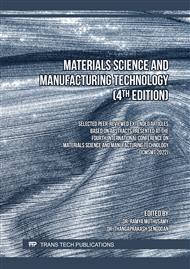[1]
C. Ayyappadas, A. Muthuchamy, A. Raja Annamalai, and D. K. Agrawal, An investigation on the effect of sintering mode on various properties of copper-graphene metal matrix composite,, Adv. Powder Technol., vol. 28, no. 7, p.1760–1768, Jul. (2017).
DOI: 10.1016/j.apt.2017.04.013
Google Scholar
[2]
Shankar, K. V., & Sellamuthu, R. (2017). Determination of optimum aging temperature and time, mechanical and wear properties for cu-9Ni-6Sn spinodal bronze alloy cast using permanent mould. International Journal of Materials Engineering Innovation, 8(1), 27-38.
DOI: 10.1504/ijmatei.2017.085809
Google Scholar
[3]
Shankar, K.V., & Sellamuthu, R. (2017). Determination on the effect of tin content on microstructure, hardness, optimum aging temperature and aging time for spinodal bronze alloys cast in metal mold. International Journal of Metalcasting, 11(2), 189-194.
DOI: 10.1007/s40962-016-0034-6
Google Scholar
[4]
Shankar, K. V., & Sellamuthu, R. (2016). An investigation on the effect of nickel content on the wear behaviour and mechanical properties of spinodal bronze alloy cast in metal mould. International Journal of Materials Engineering Innovation, 7(2), 89- 103.
DOI: 10.1504/ijmatei.2016.10000389
Google Scholar
[5]
Shankar, K. V., & Sellamuthu, R. (2015). A study on the effect of tin addition on wear and mechanical properties of spinodal alloys cast in metal mould. International Journal of Microstructure and Materials Properties, 10(5-6), 381-401.
DOI: 10.1504/ijmmp.2015.074994
Google Scholar
[6]
A. S. Jabur, Effect of powder metallurgy conditions on the properties of porous bronze,, Powder Technol., vol. 237, p.477–483, Mar. (2013).
DOI: 10.1016/j.powtec.2012.12.027
Google Scholar
[7]
Gabbitas, B. L., Ariff, T. F., & Cao, P. (2011). Synthesis of pewter alloy from tin-copper-antimony powder mixtures by microwave and conventional sintering. Powder Metallurgy, 54(4), 488-496.
DOI: 10.1179/003258910x12680382874607
Google Scholar
[8]
Mondal, A., Agrawal, D., & Upadhyaya, A. (2009). Microwave heating of pure copper powder with varying particle size and porosity. Journal of Microwave Power and Electromagnetic Energy, 43(1), 4315-43110.
DOI: 10.1080/08327823.2008.11688599
Google Scholar
[9]
D. Agrawal, Microwave sintering of ceramics, composites and metallic materials, and melting of glasses,, Trans. Indian Ceram. Soc., vol. 65, no. 3, p.129– 144, Jan. (2006).
DOI: 10.1080/0371750x.2006.11012292
Google Scholar
[10]
Reddy, M. P., Ubaid, F., Shakoor, R. A., & Mohamed, A. M. A. (2016). Properties of microwave sintered al-cu metal matrix composites. Paper presented at the Materials Science and Technology Conference and Exhibition 2016, MS and T 2016, , 2 891-898.
Google Scholar
[11]
Demirskyi, D., Agrawal, D., & Ragulya, A. (2010). Densification kinetics of powdered copper under single-mode and multimode microwave sintering. Materials Letters, 64(13), 1433-1436.
DOI: 10.1016/j.matlet.2010.03.047
Google Scholar
[12]
Rajesh, R., Shankar, B., Harikrishnan, J., Ritwik, A., Hari Krishna, A., Usman, Q., & Hari Sankar, R. (2020). Study on conventional and microwave assisted sintering of cu-FA composites. Paper presented at the Materials Today: Proceedings, , 39 1677-1681.
DOI: 10.1016/j.matpr.2020.06.151
Google Scholar
[13]
G. Sethi, A. Upadhyaya, and D. Agrawal, Microwave and conventional sintering of premixed and prealloyed Cu-12Sn Bronze,, Sci. Sinter., vol. 35, no. 2, p.49–65, Dec. (2003).
DOI: 10.2298/sos0302049s
Google Scholar
[14]
Akshay, M. C., Aravind Senan, V. R., Vignesh Surej, K. S., Akhil, B., Shankar, K. V., & Shankar, B. (2019). Determination on the effect of ti addition on the microstructural, mechanical and wear behavior of Cu–6Sn alloy in as—Cast condition. Transactions of the Indian Institute of Metals,.
DOI: 10.1007/s12666-019-01835-5
Google Scholar
[15]
Manu, K., Jezierski, J., Ganesh, M. R. S., Shankar, K. V., & Narayanan, S. A. (2021). Titanium in cast cu-sn alloys—a review. Materials, 14(16).
DOI: 10.3390/ma14164587
Google Scholar
[16]
Karthik, M., Abhinav, J., & Shankar, K. V. (2021). Morphological and mechanical behaviour of Cu–Sn Alloys—A review. Metals and Materials International, 27(7), 1915- 1946.
DOI: 10.1007/s12540-020-00899-z
Google Scholar



